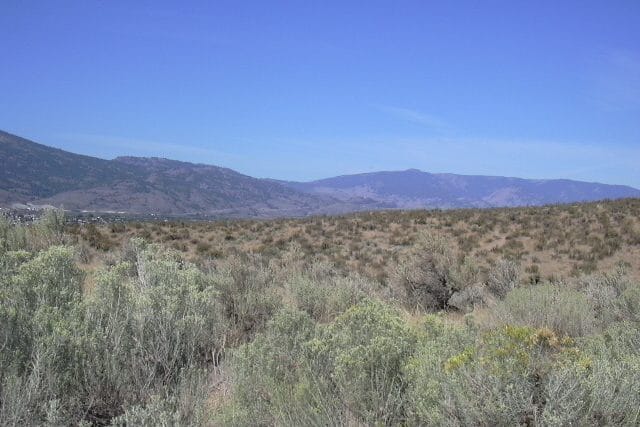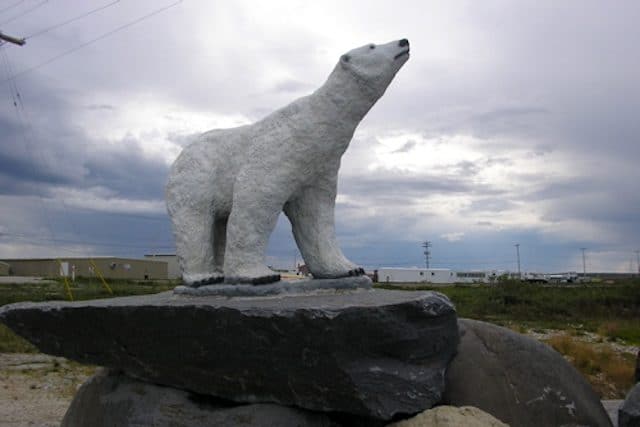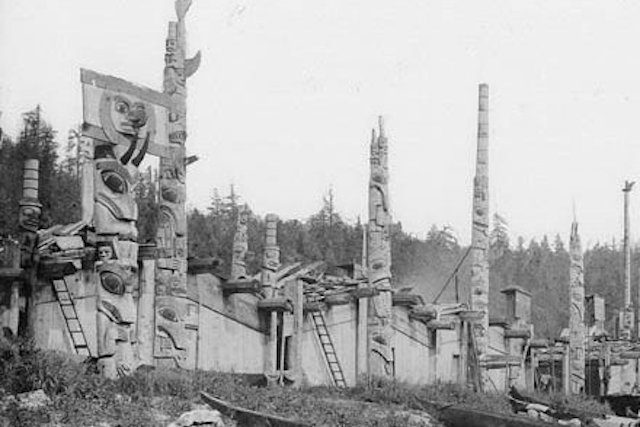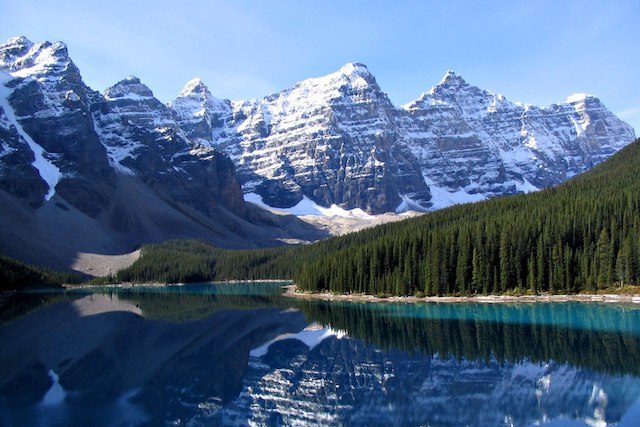10 Incredible Must-See Places in Canada
Canada is the second largest country on Earth, and home to natural and cultural heritage features that are of great interest and global noteworthiness. This list focuses on a nation that happens to be the author’s own, and one that’s also widely stereotyped for everything from maple syrup and language idiosyncrasies to giant tree-eating rodents. Sometimes less familiar in its attributes (despite its openness, massive size, and proximity to the populous United States), Canada offers many remarkable surprises. In this list, we focus on 10 must-see places in Canada that offer great intrigue and, sometimes, the ultimate unexpected surprises…
10. The Okanagan Desert

Sagebrush and the Wild West may be the stuff of countless American Westerns, but Canada has an extension of the Sonoran Desert and Great Basin landscape and associated ecosystems known as the Okanagan Desert that defies all popular imaginations of Canada as a country and a landscape. A contrast among the surrounding peaks of the True North, the Okanagan Valley’s desert is filled with rare species of plant and animal life. Transitioning from arid slopes below the montane Ponderosa Pine forests come grasslands and finally miles of sagebrush, rocky talus and parched, cracked valley floor soil.
Among these geological and botanical elements wander venomous and potentially deadly Western Rattlesnakes, Canyon Wrens, numerous birds of prey, and even an introduced population of Chukar, which is known for being the national bird of Pakistan. The Okanagan Desert is exceptionally hot, with temperatures exceeding 100 degrees Fahrenheit in summer, even rising to 109 degrees Fahrenheit in a record setting occurrence. While care is required to navigate the areas home to rattlesnakes and the intense heat, the exotic desert landscapes of the Okanagan are an iconic Western Canadian draw for curious naturalists and adventurers.
9. Dinosaur Provincial Park
Alberta, Canada’s second westernmost province, might not seem like the most likely place to imagine as a global gathering point for the dinosaur obsessed. But while Alberta’s landscape is decidedly un-Jurassic for the most part, 75 million years in the past presented a different story. Filled with tropical vegetation and enormous redwoods, the now relatively barren Canadian landscape is a treasure trove of enormous dinosaur bones in a memorial of global renown. Dinosaur Provincial Park is Canada’s outdoor museum of discovery and a site gathering naturalists, paleontologists, and associated researchers from all around the world to study dinosaur remains of incredible diversity in situ.
A UNESCO World Heritage site, the park has seen the discovery of 50 new species of dinosaur in its boundaries, while 150 full skeletons have been extracted from the almost lunar landscape that falls within Alberta’s “badlands.” Species of dinosaur made famous from their discovery at Dinosaur Provincial Park include a wide variety of carnivores, armored, ungainly beasts, and agile herbivorous species. Interestingly, the diverse formations under the hot sun and strange rock patterns that define Dinosaur Provincial Park as an inland location are a far cry from the ancient geography that even included marine habitats as the sea flowed past the area in question.
8. The Fjords of Newfoundland
Norway might be famous as the place to experience fjords of magnificent appearance but Newfoundland, part of Canada’s easternmost and most recently added province (known as Newfoundland and Labrador) boasts spectacular fjords. Formed through glacial action, Newfoundland’s fjords set off spectacular contrasts of vertical rises, deep waters and surprisingly square and table-topped rock formations. The fjords constitute a remarkable must-see natural feature that defines this unique eastern province that is a new part of the country that only joined Canadian confederation in 1949.
The somewhat under-named “Western Brook Pond” in Gros Morne National Park is a freshwater fjord formed by the melting of ice age glaciers.
Post-formation, the land rose up as glacial pressure was released, cutting the fjord off from the ocean. Flushing action made the water fresh. The so-called “pond” is 19 miles long, with towering cliffs and mountains with flat tops forming the fjord heights reaching 2,000 feet. Many species of wildlife make their home in the towering landscapes and stark waterways of the fjord lands, including songbirds, raptors, and carnivorous mammals. In the early 1900s, tsunami activity occurred in the wake of rockslides off the cliffs that tower above the waters.
7. Churchill, Manitoba

Just as China is beyond famous for its pandas, Canada is infamous for its huge and far more dangerous polar bears. The most massive carnivores on land are best seen in the Town of Churchill in the Canadian province of Manitoba. Located just 68 miles from the Nunavut-Manitoba Border, the town of Churchill is known as the “Polar Bear Capital of the World.” Tours, frozen safari-style, run to allow daring tourists to encounter polar bears close-up, albeit in protected, massive buggies. Being on a polar bear migration route, the community of Churchill gets around 1,200 of the pale furred giants coming through or past the town every fall.
There is even a “jail” to house polar bears that become too rambunctious or otherwise problematic before they are sent on their way. It’s worth noting that the diet of the polar bear is classified as a “hypercarnivore,” meaning that over 70% of its diet consists of meat food sources. The polar bear feeds primarily on seals, while fish, walruses, beluga whales, and narwhals may be added to the diet. While not territorial, humans need to exercise extreme caution in any attempt to view polar bears. When hungry, polar bears have been known to add humans to their diet on unfortunate occasions.
6. Haida Gwaii, British Columbia

North of Vancouver Island and extending north as an archipelago, or island group, to the boundaries of the Alaskan border are a hidden wonderland of cultural and geographical riches among spectacular coastal rainforests. Comprised primarily of two large islands off the North Coast of British Columbia and numerous scattered smaller islands, Haida Gwaii is a temperate rainforest treasure trove of First Nation culture in Canada. The islands represent a success story in cultural heritage protection and traditional resource management through remarkably effective treaty negotiation successes that keep the area under First Nation management.
Graced by meaningful totem poles that are hundreds of years in age, Haida Gwaii is home to numerous unique animal subspecies and a rich culture rooted in a remote and rugged but life-giving landscape and seascape. Steep cliffs are topped with dramatically wind-flagged trees, attesting to countless hours of harsh winds from Hecate Strait and the open Pacific on the east and west sides of the Islands, respectively. The aged wood that makes up the most iconic totems may recall a wooden version of the statues seen on Easter Island. Shielded from loss by a commitment to preservation, the culture of the Haida people on the islands including construction of hollowed out canoes, with longhouses and village elements that represent authentic preserved First Nation culture. The relics onsite are some of the oldest in Canada.
5. Banff National Park

The Rocky Mountains are not only the rising spine of North America, they are part of a larger geological pattern known as the American Cordillera that sees the western part of North and South America, including Alaska and Central America, studded with an essentially continuous ridge of mountains. From Alaska to Argentina, mountains tower in a row throughout the Americas. Among all these mountains, the Rocky Mountains of Canada are among the most spectacular and readily appreciated by awestruck tourists. Banff National Park is Canada’s first ever National Park, forming a key portion of the Canadian Rocky Mountain Parks UNESCO World Heritage Site.
Alpine lakes and rock faces towering peaks with sheer cliffs add to the sense of humans being so tiny as to be out of scale that can be gained from a visit to this amazing region. Charismatic megafauna with a characteristically northern flavor create the opportunity for what are some of the most thrilling wildlife viewing experiences to be had worldwide. Close views of grizzly bears, wolverines, American black bears, grey wolves, elk and marmots are some of the most noteworthy mammal species that visitors may encounter, while golden eagles and alpine songbirds are seen overhead.
4. Cathedral Grove, British Columbia
Vancouver Island, running along the south and central coast of British Columbia, is the largest island on the west coast of North America. With a diversity of habitats that make the island feel like a small continent, Vancouver Island separates the wild waters of the Pacific from sheltered inland seas dotted with islands off the mainland coast. And on this huge island, with numerous towns and cities, lies a vast wilderness expanse and extensive forestry lands.
While much of the island is now second growth or third growth forest, a preserved stand of ancient forest known as Cathedral Grove, forming the bulk of MacMillan Provincial Park, is a draw for forest lovers from all across the world. Groups of tourists visit from Asia, Europe, the US, Africa, Australia and beyond, as well as all over Canada. Gigantic Coastal Douglas-firs, some exceeding 800 years in age, tower hundreds of feet as they reach canopy height with circumferences that expand over 29 feet. Huge Sword Ferns cover the forest floor. Closer to Cameron Lake are enormous, wet soil-loving Western Red Cedars that also reach astonishing sizes. Care must be taken, as two deaths did result when a gigantic tree fell on a car in December 2003 after a snowfall.
3. Prince Edward Island
Canada’s smallest province, Prince Edward Island (or “PEI”) is also the only province in Canada to consist entirely of islands. Characterized by idyllic landscapes of rolling hills, woodlands, and beautiful beaches, Prince Edward Island is home to a famous farmhouse and surrounding grounds that were visited by internationally famed Canadian author Lucy Maud Montgomery. The farmhouse, known as “Green Gables,” was the home of the fictional character Anne Shirly, whom Montgomery was inspired to create based on her experience of the property.
Read by millions around the globe and turned into screen productions, the story of Anne of Green Gables led to the property becoming one of Canada’s top literary landmarks, being designated as a National Historic Site in 1985. Millions of visitors have come to Prince Edward Island to see where the fictional Anne grew up in the great work of Canadian literature. Now the property of the Canadian Government, Green Gables Heritage Place is located within the bounds of Prince Edward Island National Park, preserved and viewable to enchant visitors for years to come.
2. Niagara Falls, Ontario
While an exceptionally familiar location known for attracting daredevils, Niagara Falls is distinctive and charismatic. It’s not only a must-see site in Canada that deserves mention on this list, but also a physical feature of the Earth presenting numerous must-know facts. Firstly, the falls are formed by the movement of water from the enormous Great Lake, Lake Erie which flows down into Lake Ontario as the Niagara River. Niagara Falls as a natural water feature actually consists of three waterfalls and straddles the border between the United States and Canada.
While the area evokes the raw power of nature with danger right up close for the viewing, the actual physical context of Niagara Falls and its surroundings are in fact quite urban. The force of this water movement moves six million cubic feet of water per minute over the fall’s edge. Horseshoe falls in Canada is the largest and highest fall, dropping 188 feet. Horseshoe Falls stands out as the single most powerful waterfall in North America — an impressive record. Extensive folklore and tourism infrastructure add to the magnetic appeal of the site for visitors. Going over the falls in barrels and tightrope walks are among the most noteworthy stunts carried out by daring entertainers over the years.
1. Parliament Hill
Canada’s parliament buildings may not be featured in film as often as the White House, or as well known as those of Britain or many other European countries. Yet they are spectacular and, for a new world country, remarkably ancient in appearance, thanks to their particular style of old world architecture. Combining grandeur and charm, intimacy and expanse, the grounds and buildings of Parliament Hill are rich with legends and history, while serving as a central point for the hottest topics in politics and modern ceremony in Canada.
Ottawa, the capital city of Canada, is located in the province of Ontario, which ranges from warm woodlands and lakeshores to cold Northern Boreal Forest. Located along the Ottawa River, the spectacular government buildings and immaculate grounds of Canada’s Parliament Hill entice three million visitors annually. An icon of Canadian politics since Queen Victoria selected Ottawa as the capital of what was then the Province of Canada, the site is defined by dramatic gothic architecture. The magnificent Peace Tower rises among the surrounding buildings to a height of 322 feet. The Changing of the Guard ceremony offers an impressive sight to witness, featuring colorful uniforms and routines that will greatly impress the viewer.
No comments:
Post a Comment